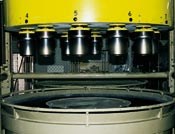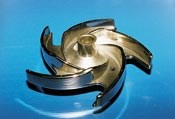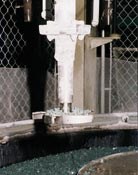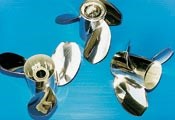A Mass Finishing Niche
Where do you go if your parts need a little more than the traditional mass finishing process?
When your parts need deburring, radiusing or polishing, you tend to think of traditional tumblers or vibratory finishing systems. However, what if your parts need that and something a "little more?" Suppose you do not want any part-on-part contact. Maybe you need the parts finished more quickly than can be accomplished manually or with a vibratory finishing system.
Sometimes there is only one way to impart a particular finish on a part. Such is the case with many impellers, propellers and certain automotive and motorcycle components. To achieve the specified finish, these parts are subjected to a specialized mass-finishing process called drag finishing.
So, if your parts require this type of finish, where do you go? Dynastar Finishing, Fond du Lac, WI, fills the niche. Headed by general manager, Chuck Kenas, Dynastar provides drag finishing for manufacturers of stainless steel pumps, motorcycle aftermarket parts, marine propellers and pneumatic tool bodies.
The concept of drag finishing goes back centuries to when farmers first pulled plows through fields. Although the farmers did not intend to polish the plows, dragging them through the abrasive soil did just that. Drag finishing employs the same concept using a circular bowl containing stationary, loose finishing media and a circular rotating turret above the bowl with multiple rotating part-fixture stations.
Chuck Kenas learned the process at Mercury Marine, where he was employed for 27 years. He could see other applications for the process beyond boat propellers and 3 years ago decided to open his own shop providing drag finishing only. He envisioned providing both functional and decorative finishes to a broad market. Drag finishing can furnish processes requiring function Tp bearing ratios of 98 to 100% at Ra levels down to 1 or 2 Ra.
Drag finishing can also be used to prepare complex-shaped parts for painting, plating and other finishes. It can also be used to refine surfaces produced by forging and casting, without changing the engineered function of the design or the artistry of the part.
However, drag finishing can also provide a highly polished finish on pieces such as golf clubs, boat propellers and medical implants.
"The parts need to be fairly high value, because the tooling part of the process is expensive," explained Mr. Kenas. "We have to fixture every part, and then the parts are dragged through the media." According to Mr. Kenas, the drag finishing process is much faster than vibratory finishing. "To achieve the same finishing on a propeller, you would probably need to run it for 40 hours in a vibratory system compared to 1 hour or less in a drag finishing system."
Programmed sequences such as rpm, depth and rotational direction provide mechanical repeatability that assure uniformity cycle to cycle. Shine and clarity are also related to compounds, fixture height and speed. Parts can be driven through the media at speeds up to 18 rpm. By combining the right media and compound with the physical action of the drag finisher, Dynastar can mechanize processes that previously only could be done manually.
Dynastar's main drag finishing set up features four machines. A polyester resin media is used in the cutting operation, and a porcelain media is used for the longer polishing operation. The polyester resin is a standard size media that wears down evenly in its original pyramid shape until eventually it passes into the waste treatment system. "We do not generate any hazardous waste," noted Mr. Kenas, "since all the parts we handle are steel and aluminum. The compounds are soaps, and the media is, basically, compacted and refined earth materials."
The one drag-finishing machine is a two-bowl system. With this machine, operators do not have to refixture parts between the cutting and polishing operations. The same media is used in this machine, however.
"We bought the fourth machine in August to relieve the pressure we were under," said Mr. Kenas. "We were working three shifts, seven days a week May through Labor Day. The fourth machine allowed us to go to two shifts."
Although vibratory and drag finishing systems use the same media and compounds, there is a monumental difference in equipment costs. Vibratory finishing systems cost on average $50,000. Drag finishing equipment prices start at $350,000.
Mr. Kenas also designed some modifications to his drag finishing equipment that allowed him to load and unload media more quickly and easily. "I used to fill the drag finishing bowl with cutting media, empty it and then refill the machine with polishing media using a shovel. This would take at least 10 hours. I figured there had to be an easier way, so I designed a stainless steel chute for loading media into the bowl. I also had a special piece of equipment rigged up so that the bags could be easily unloaded using a fork lift."
This type of ingenuity has helped Mr. Kenas in other ways as well, such as with fixturing and masking high-value, contoured parts or parts with complex geometries. Certain parts have holes and openings that must be masked off so that media will not lodge in these areas. Mr. Kenas works with the manufacturers to develop masking and fixturing so that these parts can be drag finished.
One should consider drag finishing if you have high-value contour parts; parts with complex geometries; the need for repeatable surface finishing requirements; parts that cannot risk part-on-part contact; or if hand labor is too expensive or inconsistent.
Read Next
Episode 45: An Interview with Chandler Mancuso, MacDermid Envio Solutions
Chandler Mancuso, technical director with MacDermid Envio discusses updating your wastewater treatment system and implementing materials recycling solutions to increase efficiencies, control costs and reduce environmental impact.
Read MoreEducation Bringing Cleaning to Machining
Debuting new speakers and cleaning technology content during this half-day workshop co-located with IMTS 2024.
Read MoreA ‘Clean’ Agenda Offers Unique Presentations in Chicago
The 2024 Parts Cleaning Conference, co-located with the International Manufacturing Technology Show, includes presentations by several speakers who are new to the conference and topics that have not been covered in past editions of this event.
Read More

















.jpg;maxWidth=300;quality=90)







